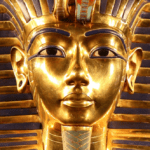 Weird Stuff
Weird Stuff  Weird Stuff
Weird Stuff  Our World
Our World 10 Ways Your Christmas Tree Is More Lit Than You Think
 Movies and TV
Movies and TV The 10 Coolest Stars to Set Sail on The Love Boat
 History
History 10 Things You Didn’t Know About the American National Anthem
 Technology
Technology Top 10 Everyday Tech Buzzwords That Hide a Darker Past
 Humans
Humans 10 Everyday Human Behaviors That Are Actually Survival Instincts
 Animals
Animals 10 Animals That Humiliated and Harmed Historical Leaders
 History
History 10 Most Influential Protests in Modern History
 Creepy
Creepy 10 More Representations of Death from Myth, Legend, and Folktale
 Technology
Technology 10 Scientific Breakthroughs of 2025 That’ll Change Everything
 Weird Stuff
Weird Stuff Ten Bizarre Facts About The Doge Meme
 Our World
Our World 10 Ways Your Christmas Tree Is More Lit Than You Think
 Movies and TV
Movies and TV The 10 Coolest Stars to Set Sail on The Love Boat
Who's Behind Listverse?

Jamie Frater
Head Editor
Jamie founded Listverse due to an insatiable desire to share fascinating, obscure, and bizarre facts. He has been a guest speaker on numerous national radio and television stations and is a five time published author.
More About Us History
History 10 Things You Didn’t Know About the American National Anthem
 Technology
Technology Top 10 Everyday Tech Buzzwords That Hide a Darker Past
 Humans
Humans 10 Everyday Human Behaviors That Are Actually Survival Instincts
 Animals
Animals 10 Animals That Humiliated and Harmed Historical Leaders
 History
History 10 Most Influential Protests in Modern History
 Creepy
Creepy 10 More Representations of Death from Myth, Legend, and Folktale
 Technology
Technology 10 Scientific Breakthroughs of 2025 That’ll Change Everything
10 Curious Facts about the Winchester Royal Bone Chests
The cathedrals of Europe are some of the oldest buildings still in use today. Many are well over 1,000 years old and have collected important historical items over the centuries. But over time, the truth about such things can easily get lost. Winchester Cathedral in the south of England houses a famous example. The centuries-old cathedral was built between 1079 and 1532 and has for hundreds of years displayed six mortuary chests—painted coffins—next to its altar.
It has long been said that these contain the bones of famous Anglo-Saxon kings, nobles, and bishops, but another longstanding rumor says that the remains inside bear little relation to the inscriptions on the boxes. Before the 21st century, nothing was or could have been known for certain about them. But in 2012, researchers began studying the contents of the chests. Here are ten fascinating things they found out and the mysteries that remain to this day.
Related: 10 Best Kings Followed By Terrible Sons
10 Their Story Began almost 1,000 Years Ago
The six chests seen today date back around 400 years to the English Civil War. But according to the names painted on the chests, what is inside them is much older. The names are of those who ruled England’s early medieval ancestors, the Anglo-Saxons, before the Norman invasion in 1066. Eight kings, two bishops, and a queen feature on the chests, which sounds like a lot of people to stuff into only six boxes.
In fact, there actually used to be ten, but over an eventful thousand-year history, four have been lost along with, eerily, some of their contents. As for what was so special about Winchester, which today is a relatively small city with a population of around 127,500, it actually used to be the capital. It was the seat of power for the early kings of England and, before that, for the Kings of Wessex. William the Conqueror would make London the capital city a little later.[1]
9 Contain Many More People Than Previously Thought
Eleven names of those presumed to be inside appear on the six chests, but things are even more crowded than that. A longstanding belief held that the remains of 12-15 people were inside, but since the chests were opened in 2012, scientific analysis has shown that they contain the partial skeletons of at least 23 people. To determine this, the scientists had to sort and analyze the more than 1,300 jumbled bone fragments contained in the chests.
While they are still working to identify most of the skeletons, they were able to confirm by radiocarbon dating that all the bones come from late Anglo-Saxon and early Norman times. This is a match for the names inscribed on the chests. The scientists even took a strange additional measure to be as accurate as possible; they adjusted the radiocarbon dating results to account for the fish-rich diet of the Anglo-Saxon nobles. This is because fish contains older radiocarbon.[2]
8 Bones Became Mixed While Moving to a New Cathedral
So, how did the contents of the chests get so confused? It really begins centuries before Winchester Cathedral was ever built. The earliest ruler named on the chests, Cynegils, died over 400 years earlier in 643. He was buried near the cathedral site, but it would be changed several times in the centuries after his death. The first church was built there in the same century, but it was eventually expanded into the Old Minster—”minster” being a cathedral.
In 901, the New Minster was built close by. But both were knocked down in the 11th century under the orders of William the Conqueror, and the cathedral which still stands today was built in their place.
With all the changes, it would be no surprise if graves had been disturbed and records had been lost. By the 12th century, when the Bishop of Winchester, Henry of Blois, decided to move all the remains from the ancient sites into lead caskets in the cathedral, it is said he did not know exactly who he was moving. A chronicler at the time wrote that “kings were mixed with bishops, and bishops with kings.”[3]
7 The Bones Once Used to Break Windows
Changes to the cathedral site were not the only events that caused the contents of the bone chests to become confused. In the 1520s, a bishop called Richard Fox removed the bones from the lead boxes and placed them into chests. They were kept in the cathedral with another set of individually buried royal remains, which meant there were ten chests altogether. Four of the surviving bone chests are Fox’s originals, and two are replacements, which means six were lost. And what is known about what happened to them is quite shocking.
Parliamentarian soldiers, popularly known as “Roundheads,” raided the cathedral at the start of the English Civil War in 1642. They smashed the bone chests open on the ground, picked up the scattered fragments, and hurled them through the cathedral’s stained glass windows. After the attack, locals gathered up what bones they could find and placed them back into the remaining chests. But, of course, they had no way of knowing whose bones were whose.[4]
6 The Bones of a Legendary Queen
Queen Emma of Normandy is the only woman named on the bone chests, and the analysis of the bones revealed the chests only contained one female skeleton. The skeleton belonged to an older woman, which matches the details of Queen Emma, who had time in her life to marry two kings of England and give birth to two more. A powerful political figure, Emma first married Ethelred the Unready in 1002 as part of a plan to unite England and Normandy in defense against the Vikings.
Ironically, after Ethelred died in 1016, she married the next Norse king of England, Cnut, who also ruled Denmark and Norway. She gave birth to future kings Edward the Confessor and Harthacanut, and she had a strange relationship with Edward. While king, he accused her of having an affair with a bishop. To prove that she was innocent, he granted her a “trial by ordeal”—she would have to walk barefoot over nine burning plowshares in Winchester Cathedral. After saying her prayers, she walked across the hot iron unharmed and restored her reputation along with the bishop’s.[5]
5 Store the Remains of an Assassinated King?
Although his father was buried back in France, the remains of William II, son of William the Conqueror, are said to be among those in the Winchester bone chests. The second Norman king died in what was officially claimed to be a hunting accident in the New Forest, not far from the city, on August 2, 1100. He was shot by an arrow fired by Sir Walter Walter Tirel, who then fled to France.
Many believe Tirel assassinated the king under orders from William’s brother, Henry, who was next in line to the throne as William had no heirs. It is not certain that this was the case; hunting was a dangerous sport, and accidents were common. Nonetheless, it remains one of the most infamous monarchical deaths in English history, and it is also surrounded by morbid mysteries.
That morning, William had a terrible nightmare in which he saw the sky filled with his blood. In another retelling, he sees the devil, who said he was looking forward to seeing him. To this day, his ghost is said to haunt the New Forest, doomed to forever walk the path along which his corpse was taken to Winchester.[6]
4 Could Another King Be Inside Too?
Named on the bone chests alongside his wife and son is King Canute. This highly effective ruler united England, Norway, and Denmark under his rule to form the North Sea Empire. Powerful though he was, Canute is often remembered for a famous failure.
The story goes that the king’s chair was carried down to the shore, where he sat on it and said to the sea, “You are subject to me, as the land on which I am sitting is mine, and no one has resisted my overlordship with impunity. I command you, therefore, not to rise on to my land, nor to presume to wet the clothing or limbs of your master.” When this obviously did not work, he exclaimed the worthlessness of the power of kings compared to God.
This tale, along with Canute’s name, has worked its way into the English language, where it is used to describe arrogant people who think they have the power to prevent something inevitable from happening. However, some historians say this is a misinterpretation. Canute was not arrogant but was demonstrating the point that God’s power was greater than any Earthly king’s.[7]
3 Bones of Two Children
The bone chests held more surprises for researchers than the discovery that there were at least 23 skeletons instead of the expected 12-15. One big surprise was that two of the skeletons belonged to children. They were believed to have been boys who died between the ages of 10 and 15. The fact that they ended up in the boxes means they were “almost certainly” royal, according to experts. Yet they are stumped as to the identity of the duo.
Many people suggested they could be the sons of King Edward IV, who are believed to have been murdered in a plot by Richard III, their uncle who was supposed to look after them after their father died. However, those events took place in 1483, whereas the skeletons in the chests died sometime from 1050 to 1150.[8]
2 Stored alongside an Enormous Medieval Bible
The mortuary chests date from a time when belief in Christianity was becoming stronger in Britain. Cynegils was the first Christian king of Wessex. Canute believed piety was important in his role as king, and Edward the Confessor became a saint. The chests are also not the only artifacts from this time that survived inside the cathedral. In 2019, they were exhibited alongside an amazing 12th-century Bible.
After its own five-year conservation project, visitors could finally see the almost 1,000-year-old, 70-pound (32-kilogram) book. Remarkably, it was written by only one scribe who, after four years, still had not finished. He wrote on the skin of 250 calves, and later, six artists would decorate the book with gold leaf and other colorful illuminations.[9]
1 Connections to the Current Royal Family
The chests are said to contain individuals from before and shortly after the Norman invasion of England by William the Conqueror. His invasion was the point at which England began numbering its rulers, which then begs the question of whether the present royal family is related to those in the chests. Surprisingly, given the many wars over the centuries between then and now, the answer is yes.
Queen Emma of Normandy was a great-aunt of William the Conqueror (it was through her that he had a claim to the English throne), and he is a 23rd-great-grandfather of King Charles III. Winchester Cathedral has other royal connections, too. It was the venue for the 1554 wedding of “Bloody” Mary Tudor, and a chair from the ceremony is still there. Scenes from the TV series The Crown were also filmed there, and it has links to literary royalty; Jane Austen was buried there in 1817.[10]








